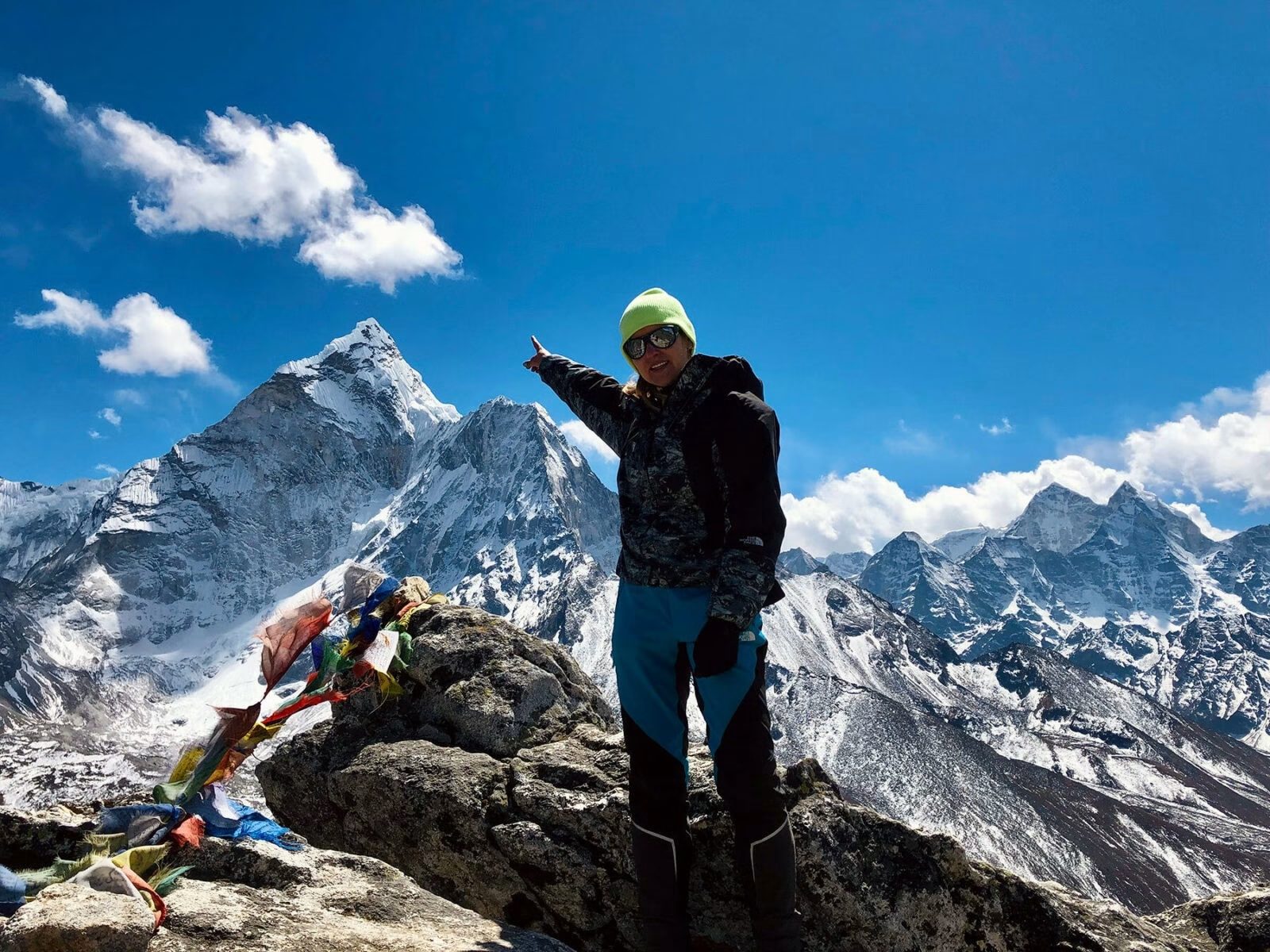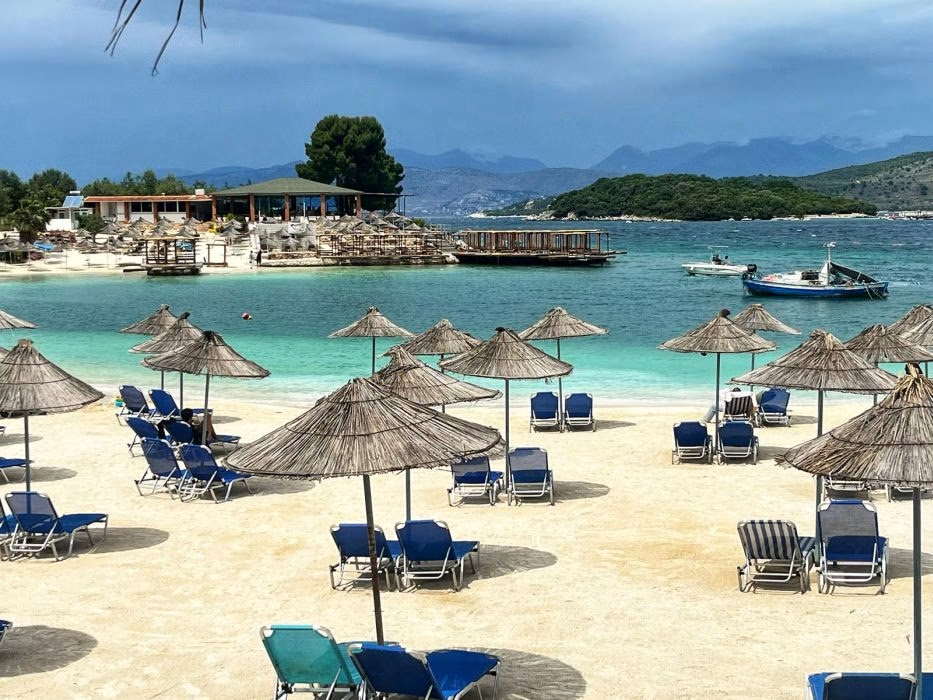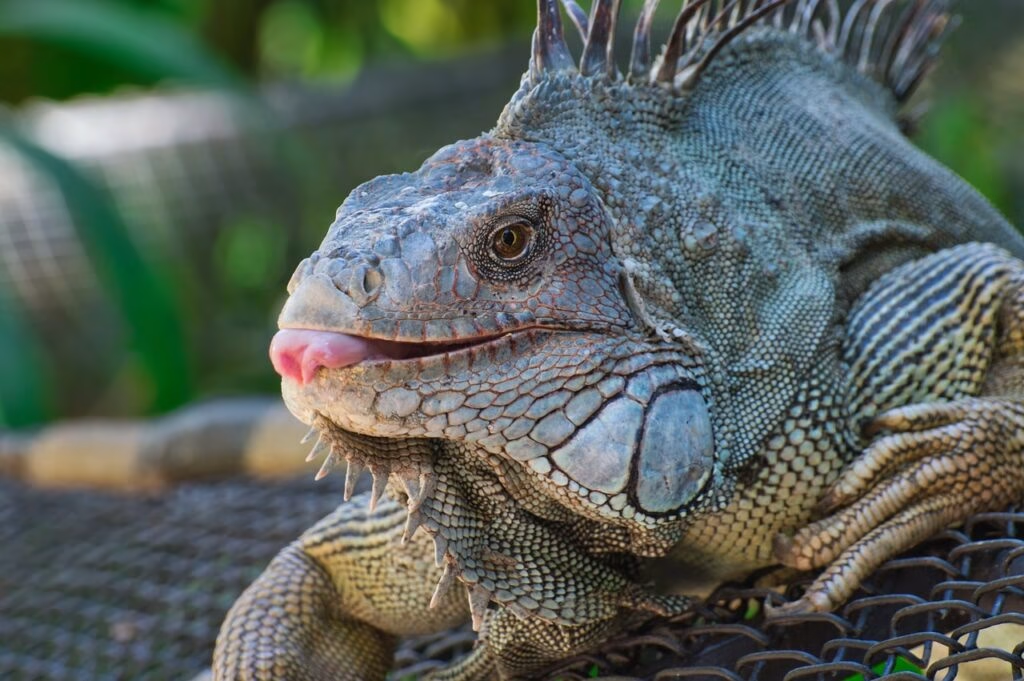At high altitudes. Namaste..
I’ve dreamt about trekking Everest Base Camp Trek for years and my desire strongly escalated after Everest movie released in 2015 (which I probably watched 350 times now!). While I found myself on different trekking and climbing paths over the last few years, I always carried Everest trail in my heart. Who wouldn’t like to experience magnificent Himalayan treks and see the unbeatable beauty of this region. Or get to know one of the most amazing people on earth – Sherpas, one of the Tibetan ethnic groups, who are most famous for their 8000m height achievements.
Everest Base Camp Trek guide for beginners.
Even though I can’t climb the top of this mountain (yet!), this journey was a lifetime adventure. Walking through Khumbu valley gives you unforgettable views of the surrounding and overwhelming beauty of mountain nature. There would be a lot of people reaching EBC just for the aim of a social media shoot. For me the whole trail was like a spiritual awakening and energizing experience of majestic Himalayas. Firstly, don’t go there for the spot, but go there for the complete journey and you’ll be surprised how much is there to discover on the way to Mount Everest Base Camp. Take your time, find your pace and experience this phenomenal place stage by stage.
If you’re looking to prepare yourself for this adventure, here is a complete 14 days guide on how to get to Everest Base Camp with day by day description for all stages.
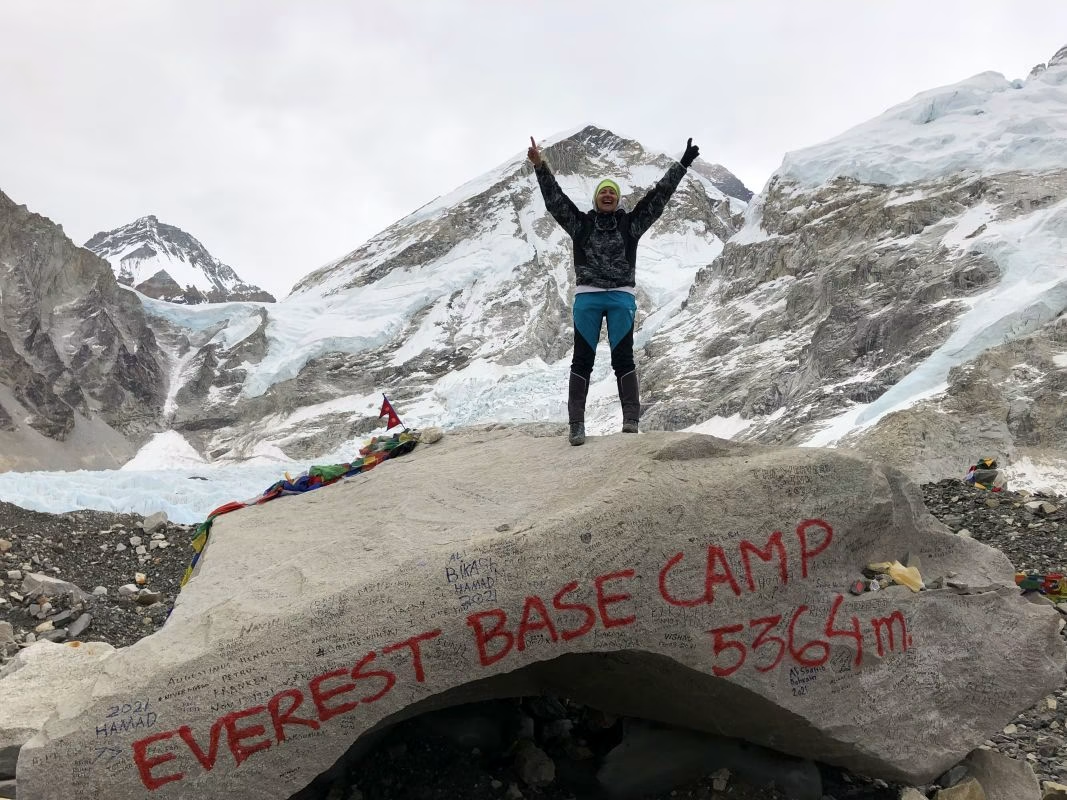
How difficult is Everest Base Camp Trek?
Remember Adventure Consultants led by a New Zealand mountaineer Rob Hall – they are still operating in Nepal. You can see their stickers on front doors of the lodges and restaurants on the way to EBC. BTW their website describes EBC trek as LOW Difficulty and Fitness level 😉. Outside of my huge sympathy for this agency I would strongly disagree with that.. Obviously this trail would be an easy challenge for professional climbers but not for adventurous trekkers. I heard some people saying this was the hardest thing they accomplished in their life. For me it was hugely challenging (mostly because of the altitude sickness). There was a lot of people who got sick in Gorakshep – the last village from where you leave for EBC. Also, at the last stage only few people left to climb the highest peak of the trek – Kala Patthar. Everest Base Camp Trek should never be described as EASY.
If you are wondering is trekking Everest Base Camp safe, I’d say most of the trail it is. But don’t forget 21 people died in the Himalayan Base Camp in 2015 avalanche, while the earthquake killed nearly 9000 people in Nepal.
Everest Base Camp Trek cost.
There is no fixed price for Mount Everest Base Camp Trek. It depends on number of aspects – the length of the trek, route and a service. The prices would vary from $1100-$4500.
I was very keen to do 14 days EBC trek, to allow myself for a proper acclimatization. 9 days treks are better for extreme climbers.
My Everest Base Camp Trek with Exciting Nepal Treks and Expedition (www.excitingnepal.com) cost $1285 in March 2022. You can check prices online. The agency had brilliant reviews and this is what made me decide to talk to them. While some of the companies would offer the luxury package of similar expedition at the price of $4000-4500.
For me luxury doesn’t go with climbing. I was trying to keep my expedition as real as possible and I didn’t want anyone to carry my stuff. I wanted this experience to be mine and I believe if you can’t do it alone you shouldn’t be in the mountains at all. My guide still had some of my equipment and he was providing a beautiful care through all the way!
Medical insurance for Everest Base Camp.
As mentioned here, you absolutely need a medical insurance with helicopter evacuation for Everest Base Camp trek. After years of traveling I settled with SafetyWing, it is the most comprehensive insurance in my opinion, flexible with pricing and start date, provides great coverage in case of injuries or emergency evacuation.

Sherpas - why they are superhuman climbers?
Sherpas’ hearts have a greater capacity which may explain their amazing ability to breathe easily at the world’s highest altitudes. Above all, it’s rather because of their sweet, big hearts, as they are truly amazing, carrying and vulnerable people. I could listen to my guide for hours, while he was telling me about all his mountain expeditions in Nepal, China/Tibet and Bhutan. About how they live, what was their childhood and do they really like taking bunch of fussy travellers up there.😉

Do you need a guide to trek Everest Base Camp?
YES – from April 2023 Nepal authorities decided all foreign trekkers and hikers, whether solo or in a group, must have licenced guide. There are hundreds of reasons for this regulation to go live but most importantly it is to ensure safety and security for all Himalayan travelers. The route to EBC is pretty obvious and easy to follow but there’s plenty of things you should know before approaching any Himalayan trek. I could not imagine going without a guide for number of reasons. Firstly, the guide helps you acclimatize properly and manages your health condition while ascending and descending! Most people do have high altitude sickness symptoms, especially closer to the level of 5000 metres and often it’s just a case of managing your condition accordingly. I would never risk doing it on my own (perhaps after years of experience), although in 2022 there was a German guy who was hiking EBC alone, he struggled on the way up but eventually managed to reach EBC with a bit of a help and advice from other guides.
How to pick the right trekking agency?
I googled few agencies to go through their offer, you should do the same for comparison. Prices differ so much and you will pay triple if you pick agency based in Europe – UK or Irish. This was one thing I definitely wanted to avoid – to be led by a company from Europe. Why would you pick a company from Europe if there are so many brilliant local operators, based in Nepal, hugely experienced and customer focused. I didn’t want my trip to be organized or accompanied by anyone outside Nepal.
I googled my agency, which was Exciting Nepal Treks & Expeditions, I liked their website, very factual trail description, great rating and I liked the fact they operate in few countries: China, Nepal, Bhutan. Subash the owner, was so quick in reverting to my email that I knew from the start that’s going to be my guide. His runs well established agency, with over 15 year experience on the market and a great (99%) success rate 😉 They provide different types of expeditions and Suman my guide was the greatest companion I could imagine! The trail would not be the same without him! Warm, lovely, carrying and extremely reasonable. Loved his stories, especially the one from his childhood.
Jump to their blog to read guest post about my EBC Trek.
Suman my Guide 😉

Mount Everest scenic helicopter tour.
Helicopter tours from Kathmandu are becoming more and more popular, since on a few hours tour you can witnes the most incredible aerial views of Himalayan peaks, glaciers and valleys and Everest -the tallest mountain in the world.
Acclimatization at high altitudes - your key to success on every mountain.
Climbing is very much about your physical condition but it’s mostly about oxygen and the lack of it. The concentration of haemoglobin, which carries oxygen in red blood cells increases gradually to provide more oxygen. The more time you give yourself to adjust to the lack of oxygen, the more chances you have to succeed safely. That’s why I am definitely recommending 14 days trek, which in fact is 12 days, as you spent 2 in Kathmandu getting ready for the trail. The trek would be much harder if you tried to complete it in under 12 days!
The key thing to success this trek is a natural acclimatization. Therefore, it’s important to go with a professional agency, led by an experienced guide. He will have the best acclimatization schedule based on the rule – go high, sleep low. It is key to acclimatize well starting from low hights, otherwise you will struggle at higher levels. There is an extra day in critical acclimatization points – Namche Bazar 3450m and Dingboche 4350m, to give you time to adjust your body to low oxygen levels. Once reaching Lobuche you will trek a bit higher than you sleep, otherwise you can wake up with a headache or other high-altitude symptoms. After we reached our lodge, we had a short lunch break before we trekked another 200-300m up and back down to allow body to acclimatize naturally.
High-altitude symptoms while trekking Everest Base Camp.
Being accompanied by an experienced guide is crucial. You will need his invaluable expertise on the way up, he will help you cope with all high-altitude symptoms and will know how to best manage your condition. Some guides do daily check-ups among the trekkers and keep a record of it. They do a short interview, check the level of oxygen in the body, temperature, etc. Professional guide is familiar not only with the medications, but other methods preventing from getting sick – like garlic soup, ginger honey lemon tea, amount and type of food you should have in particular times of the day. In high mountains every little aspect counts and has fundamental impact to accomplish the trek successfully.
Everest Base Camp Trek - practical information.
TIME: best time for Everest Base Camp Trek is:
- March to mid-May
- September to mid-November
It is possible to hike this Himalayan Base Camp all year round but in winter months the temperatures drop to very low and there is a lot of snowfall. While in summer months the weather is wet and cloudy with a limited visibility of the surrounding peaks.
DIFFICULTY LEVEL: Moderate
LENGTH: 12-14 day – 130 km in total.
ALTITUDE: EBC 5364m, Kala Patthar 5640m.
FATALITIES: People dye each year on the low and high end (12-15 people a year) of Everest Base Camp trek.
DANGER: Main danger for trekkers on EBC trail is altitude sickness.
TRAVEL INSURANCE: Make sure you have travel insurance which includes helicopter rescue!!!
Hydration at high altitudes.
WATER – the most important thing at high altitudes. To acclimatize properly you would need to drink 4-5 litres of water a day! YES, that’s correct! You can buy or refill your water bottles from tea houses on the way. The price of bottled water raises with the altitude (it’s still only 1-3$/per 1l bottle) but there is not much you can do about it, unless you carry water purifying pills and use running water, which I don’t recommend, as it’s too much of a hassle.
Sagarmatha National Park.
There are many things forbidden to do in the Sagarmatha National Park – camping, playing music, bringing in/out wild animals, etc. All is listed on a big board while entering the Park.
Yaks – long-hair with horns, high altitude cousin of the Tibetan cow. Among donkeys and horses they are the one who carry the heaviest loads /especially for those who climb M. Everest/– the animals always have a priority on the trail. IMPORTANT rule you have to remember, always stay on the mountain side/not the edge side/. Otherwise Yakis may push you down from the edge.
You will stay in Sherpa’s lodges. They are lovely but at higher altitudes you would definitely need an extra clothing and blankets to keep you warm. And forget about shower 😉In March all pipes were frozen and even Lukla was without electricity.
Everest Base Camp Trek - day by day guide.
Day 1: Arriving in Kathmandu (1300m)
Day 2: Kathmandu arrangement day
Day 3: Flight from Kathamndu to Lukla (2860m) and trekking to Phadking (approx. 6.5km)
Almost everyone heard about Lukla Airport, which has the shortest lane in the world. Lukla lays on the altitude of 2900m which makes it one of the highest airports in the world. Flight takes about 40 minutes and can be really rough due to the mountain area, thick air and small aircraft which is sensitive to a windy weather. The plane flies between the mountains and at the same time you can admire the incredible view of Himalayan Caldera!
The flights to and from Lukla highly depend on the weather. High altitude makes this airport one of the most dangerous in the world. Moreover, visibility plays a key part on the flight schedule. Also forest fires often break out in the Khumbu Valley, which cause serious flights delays and cancellations. Fire smoke coming from the valley has a huge impact on the visibility of the airline runway. Moreover, there is no space for a mistake at Lukla airport, with a vertical rock below and above the airport. The lane is very short and it’s crucial to land the plane as quickly as possible.
Few years back a cargo plane crashed in Lukla, he missed the lane and hit the cliff just below the airport runway. Crazy when you think about!
Flight from Kathmandu to Lukla.
Our flight from Kathmandu was at 6.30am. We had to get up at 4 to leave the hotel at 4.45 to drive to the airport. The airport opens at 6am but there was already a queue in front of the entrance waiting to get in. Aircrafts to Lukla take on board 14-18 people. The shuttle bus taking us to the airplane stopped and the captain got in to say there is a fire in Lukla valley and the visibility is too poor for the planes to land and Lukla airport has been closed. We are waiting for the permission from Lukla to take off, depending on how the situation will progress. After an hour waiting, we finally heard the good news that the airport has reopened and we are ready for boarding.
Our captain was extremely cool-headed and after a beautiful flight he landed in Lukla without a tiny problem. It takes up to 10 minutes to get out of the plane, grab you backpack and find yourself in the nearby tea house for a hot drink. The temperature is way lower than in Kathmandu. You wouldn’t leave your jacket here, but it gets sunny and warm on the way up. Now the trekking begins! Shortly after landing in Lukla you trek to PHAKDING (2650m).
Leaving Lukla for Phadking 2650m – still Day 3.
We started trekking at 8.30am to reach Phadking after 3 hours. The first day is pretty easy, so this would be a light and pleasant trek toward Phadking. You will reach Phadking for lunch around 12 and after hike a magnificent monastery. It will take approx. 1h up and 1h down with entry 300 rupees but well worth to visit. The monastery is very similar to one in Tengboche, known as the most sacred placed on the way to Everest. Mountain view from the monastery is incredible.
Day 4: Trek from Phadking 2650m to Namche Bazar 3445m (around 10 km).
We started at 8am to reach stunning Namche for 3pm including a long lunch break. The trail is not too difficult and if you get a sunny weather it will be a lovely hikking. You will also walk few rope bridges hanging above the valleys 😉 And of course the famous Edmund Hillary Suspention Bridge! Namche Bazar is one of the most popular villages on the way to EBC. This may also be your last time you’ll shower on the way to EBC. The lodge was lovely, great food, amazing evening atmoshere in the restaurant, Everest movie watching! View from my window in the bottom photo, I could not stop starring at the sunset!!
Day 5: Acclimatization day in Namche Bazar.
On your acclimatization day you will take a walk around Namche Bazar, visit Sherpa Museum, the famous monument of Tenzing Norgay and hike Everest View Hotel located at 3850m. You can get a clear view of Mount Everest from this hotel, if you are lucky with the weather. The is a nice outdoor restaurant where you car spend few hours admiring the surrounding Himalayas. In Sherpa Museum check the very first crampons they used in early 50s, also by Tenzing Norgay while climbing Mount Everest – imagine this!! It’s better to get to the view point early in the morning, less chances for cloudy sky.
Day 6: Trek from Namche Bazar to Tengboche 3850m (9.5 km).
Now it’s getting a bit challenging – it’s not about the path, neither the length of the trek, it’s about the fact that first you trek down to the altitude of 3000m to take a bridge over the Imjatse river and then hike up to 3850m. It’s 10km in total but it’s a huge altitude change even for experienced trekkers. Just after you reach Tengboche and drop your bag in your lodge, you will be taken to the famous monastery to take part in monks players, which usually start around 4pm. This is the most famous Tibetan Buddhist Monastery (also known as Dawa Choling Gompa) on the way to Chomolungma Mountain in the Tengboche village in Khumjung in the Khumbu region. The Monastery is famous for its stunning interior and incredible monks prays.
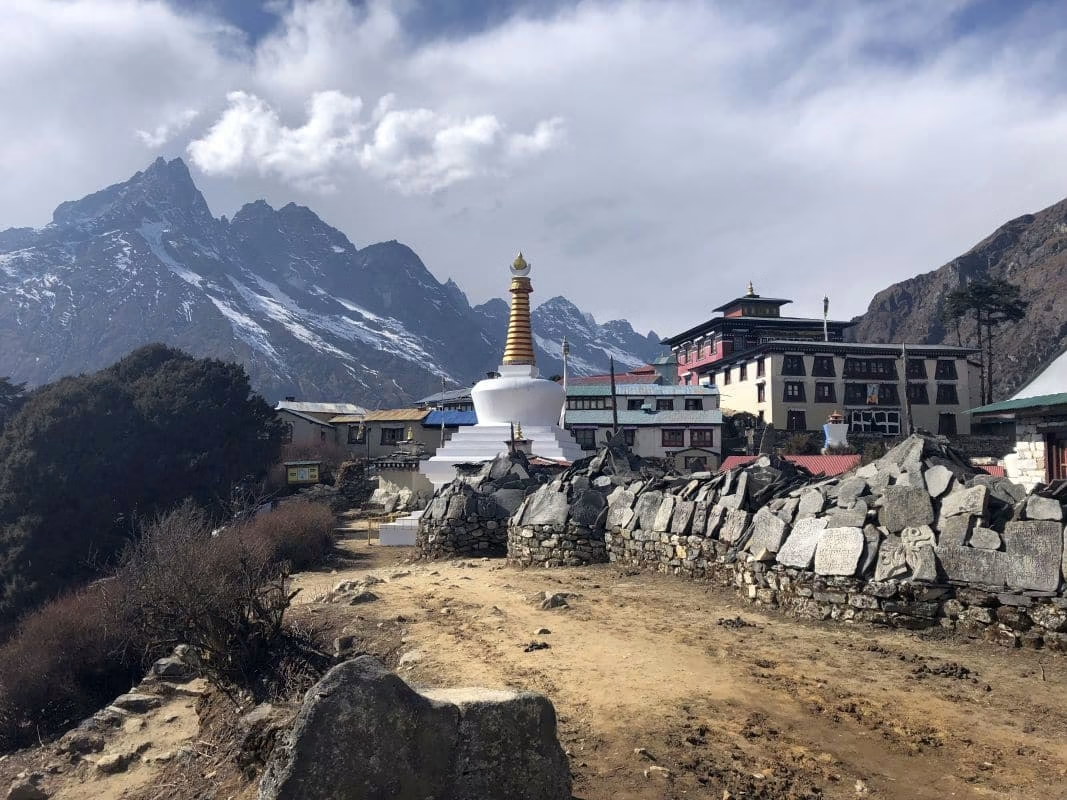
The mass is exactly like in the Everest movie. It’s a beautiful and touching session and I dreamt of being present there for this special occasion but my problem at that stage was unsustainable .. a headache at the back side of my head, which isn’t a good symptom. It was so bad that my guide Suman gave me two choices – going down to Namche Bazar and hiking Tengboche the next day again, or taking Diamox – the most popular medication for altitude sickness. No chance I go back to Namche.. so it was a quick decission, I go on Diamox from now..! Interesting experience, I was trying to avoid taking any medication, but it was impossible to cope with the headache. I just couldn’t risk my whole hiking adventure and not take the tablets.
On the way to Tengboche it is very likely you’ll see Himalayan Thar, a mountain goat that looks like an antelope.
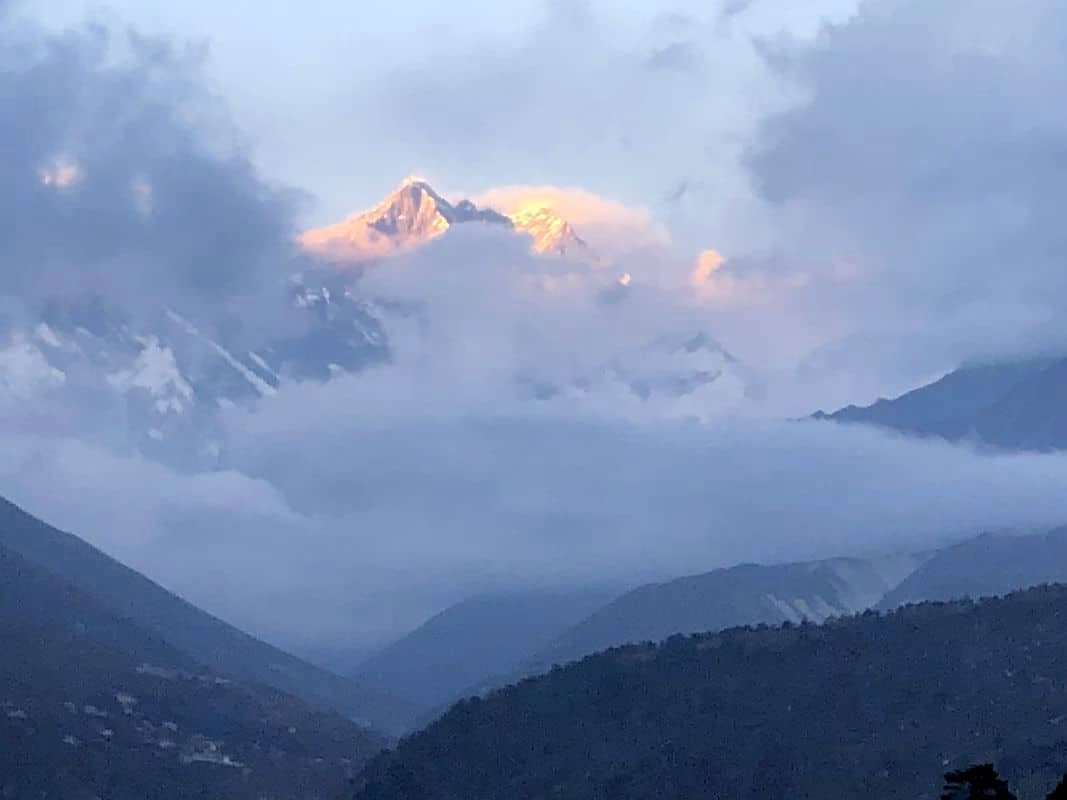
Day 7: Trek from Tengboche to Dingboche 4350m (11 km).
The views on the way are breath-taking! Especially around small village Deboche with magnificent view of Mt. Everest, Nuptse and Lhotse. At first the path leads through a forest.
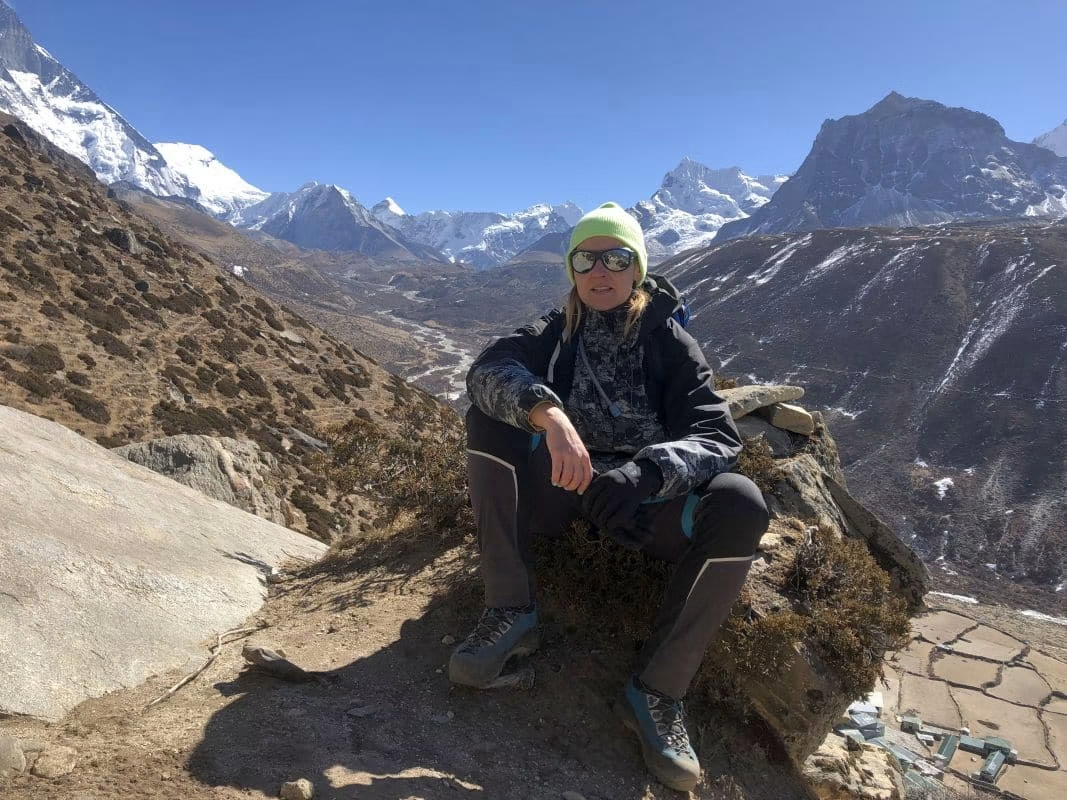
Day 8: Acclimatization day in Dingboche
On day 8 you’ll be hiking to a viewpoint which lays at the level of 5000m. It’s a 2-3h hike up and 1.5h hike down. Most of the groups would be heading toward this peak, although many reached only halfway. After all, only few people were determined enough to get to the summit, which rewards with absolutely stunning mountain landscape. The trek is pretty tough with a very steep last section, basically rock climbing.

Day 9: Trek from Dingboche to Lobuche 4950m (around 5.5h).
It takes about 5.5h to reach Lobuche. After having lunch you will still need to do some hiking to support acclimatization. Without doing this the guide will not allow you to rest. Simply because if you go to sleep straight after reaching Lobuche there is a huge chance you will wake up with a headache or other high altitude sickness symptoms.
Night temperature in Lobuche was low and the moment you walk into your room feels like walking into the ice cube. Nights were very cold but it was more manageable that I thought. Your body will adopt to new conditions and you can always ask for an extra blanket, which are very warm.
Typically in the evening time everyone will gather in a dining room, firstly to eat something hot and also because this is the only room with a fire place 😉The fire is usually located in the middle of the room, where all trekkers, porters and guides spend the evening to warm their bodies before going back to the icy rooms.
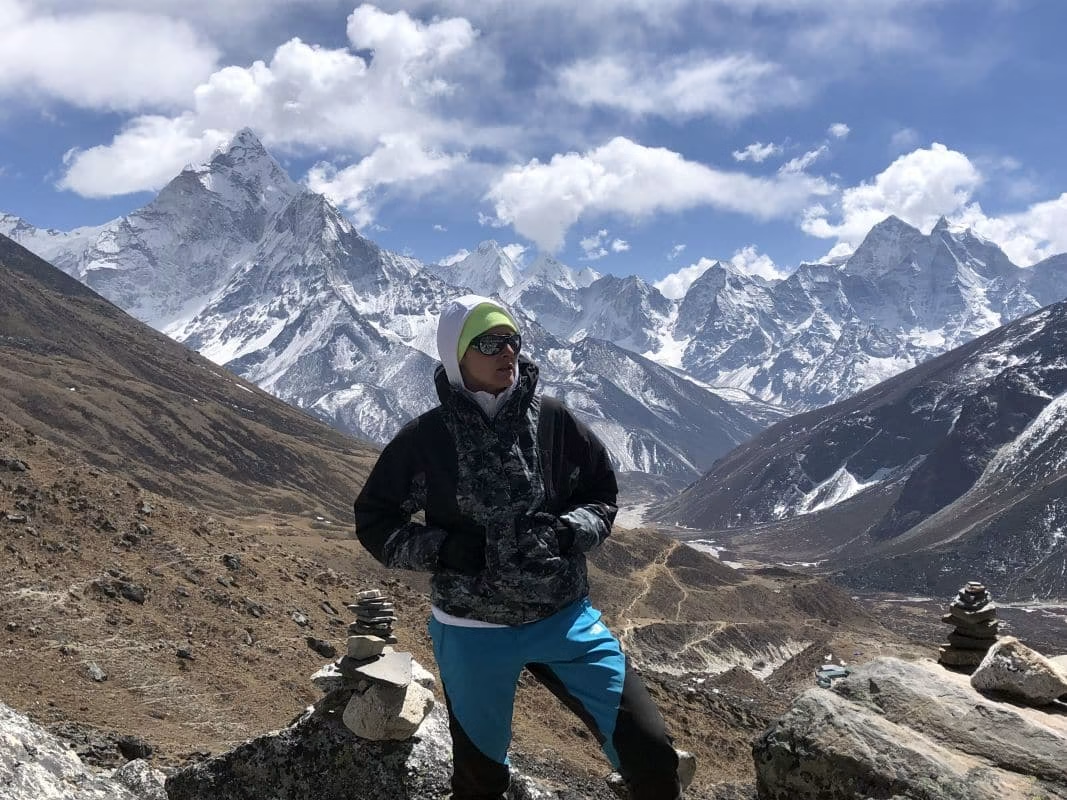
Day 10: Trekking from Lobuche to Gorakshep 5160m. Trekking to Everest Base Camp 5364m and back to Gorakshep.
This is a hard day, but the excitement is stronger than any fatigue. Once you’ll reach Gorakshep (3h from Labuche) you’ll drop off your backpack before trekking to Everest Base Camp to 5364m. It takes approx 3 hours to reach EBC from Gorakshep and 2h back. The hike leads through the icefall and I have never seen more spectacular views in my life. You are basically walking on tons of ice. Above all, reaching Mount Everest Base Camp is so rewarding it’s actually hard to describe. Some poeple are crying, some are extremely happy – like me! The weather was really kind that day. Pure air and uniterrupted visibility equals unforgettable scenery. If you take a short walk around the camp you can access the glacier. I’m finally there – Mount Everest Base Camp 5364m!
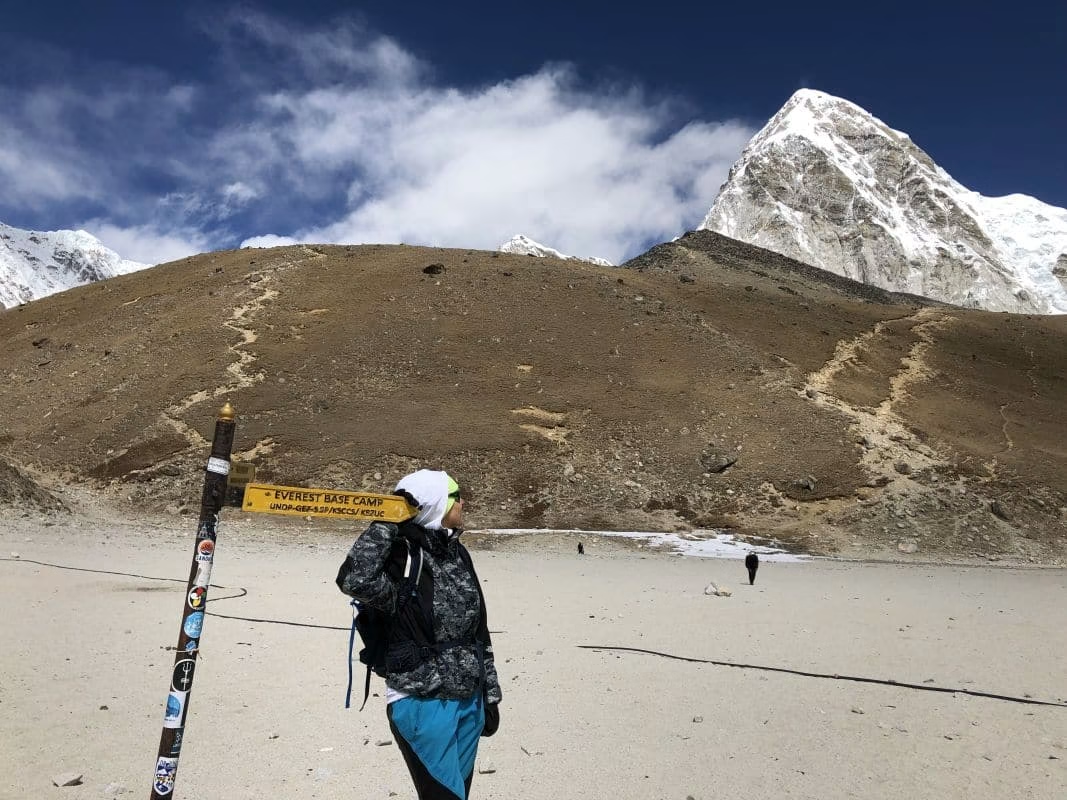
In the evening it’s time to celebrate reaching EBC but there’s something else on your mind at that stage.. Will I make to climb Kala Patthar. People are already exhausted at this point of the trek, they feel sick and cold shivers your body. Although everyone is extremely tired you can’t get enough sleep.. It’s hard to describe how helpless you are with the altitude sickness!!
Day 11: Night trek to Kala Patthar 5644m and dramatic views of Mount Everest. Trekking down to Pheriche 4371m (19km in total).
No chance I won’t try to climb this bloody mountain, I said to myslef! You can’t get lot of sleep at that stage but I still manage to get 4 hours rest. My guide is knocking on the door at 3.30am, there’s no way I’m leaving this bed, it’s freezing cold outside! He knocks so hard that I have to get up and let him in. Suman quickly says – get ready we are leaving in 15 minutes! I look up at the sky and cannot stop starring, I’ve seen starry skies before but this one is indescribable!! I’m not able to reach my phone out of the pocket to take a shot of this phenomenon, it’s too cold! I don’t know why I’m struggling with this cold so much.. I come from Poland, when I was young we used to walk to school every day in -30 degrees. Except the fact it was a 15 minute, not 10 day walk ;).
Night hike to Kala Patthar 5644m.
Meaning ‘Black Rock’ in English, Kala Patthar has an elevation of 5,644.5 m (18,519 ft) and is a trekking peak famous for its incredible summit views and a dramatic view of Mount Everest. Kala Patthar is so popular, as it is one of the highest points in Himalayas that can be reached without technical climbing. But you have to remember you are getting really close to that extreme altitude level. With 50% less oxygen getting to your muscles, you have to make sure you acclimatize correctly in the early stage of the trek to be able to reach kala Patthar.
You will spend a night in Gorakshep, although it may not get a great sleep at this altitude. You’ll leave around 4am to trek 2 hours to the top and 1.5h down. The path is not too difficult but it get challenging with the cold and the increasing altitude. Beside the top of Kala Patthar is not visible from the bottom, which makes it mentally challenging. A night trek in Himalayas was something new for me but once you look above and see the sky drawn in stars, it feels incredibly empowering.
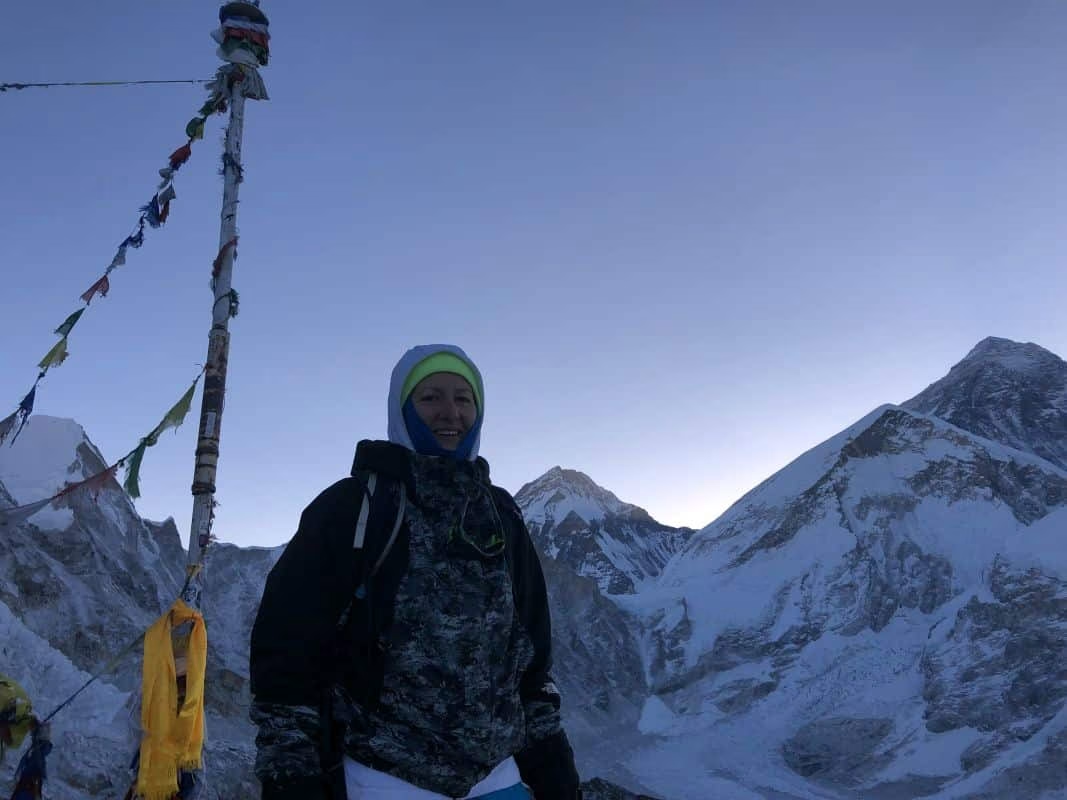
Climbing Kala Pathar – the hardest stage of Mount Everest Base Camp Trek.
It’s a night trek to welcome sunrise at the top of the mountain and experience a magnificent view of giant peaks – Numptse, Changtse and Lhotse. If you want to capture all these peaks in a golden sunlight you need to do this hike in the afternoon. Trekking early in the morning is dark, cold and exhausting. I have to say, I had to make a lot of effort at that stage and dig deep to go out for this last climb. I just followed my guide and my headlight mark on the snow. The temp was below -30 when we left the shelter. All my water in a camel bag and a bottle was frozen within 15 minutes and it was so difficult to stay out of hydration. Beside, I was on Diamox which requires plenty of water intake, but it was simply impossible to stay hydrated in these conditions 😉
At the top of Kala Pathar!
There weren’t many people who decided to trek Kala Patthar that day, most of the trekkers resigned after reaching EBC. To be honest, I was actually surprised that they even weren’t tempted to try. Moreover the trekkers were encouraged by the guides to try and trek half-way if it occurs too difficult or exhausting. But most of them resigned anyway. I dreamt of reaching both – Mount Everest Base Camp and Kala Patthar. I can’t describe how happy I was when I did! It felt incredible at the top! Looking from Kala Patthar peak at Mount Everest, it seems to be just right behind you! The sun was slowly illuminating the snow mountain peaks with magic lights, but unfortunately it didn’t get warmer 😉 Above all, the only thing in my mind on the way down was hot tea and hot hot hot breakfast. The happiness was still running through my veins! I was so energized!
Straight after your breaky you start trekking down to Pheriche. This is a very long day, we reached Pheriche for 4pm. Don’t forget that food and hydration is equality important on the way down, as you’ll be trekking 20km a day from now.

Day 12: Trek from Pheriche to Namche Bazar (approx. 20km).
From now you are heading lower elevations, try to enjoy the last 2 days as much as possible. I was living every minute of this magnificent adventure, but after few cold days and freezing Kala Patthar, I couldn’t wait until we reach warmer levels.
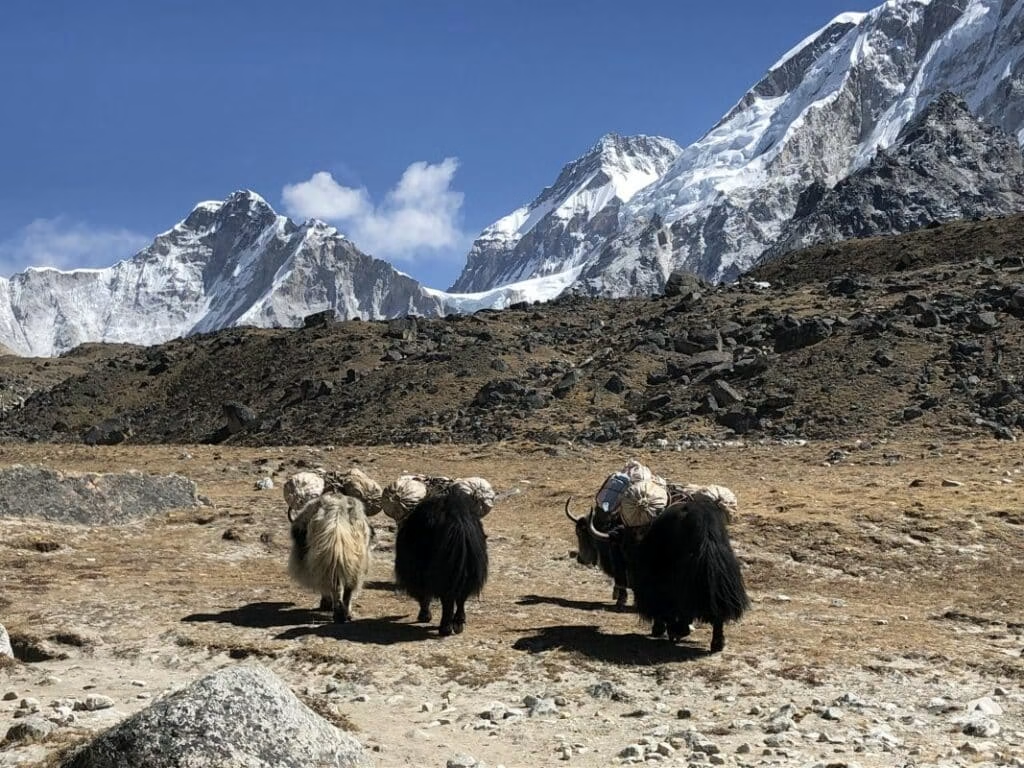
Day 13: Trek from Namche Bazar to Lukla
Despite the 20 km route (mostly up on the way to Lukla) my body was functioning well and I was very happy to be at a lower altitude.
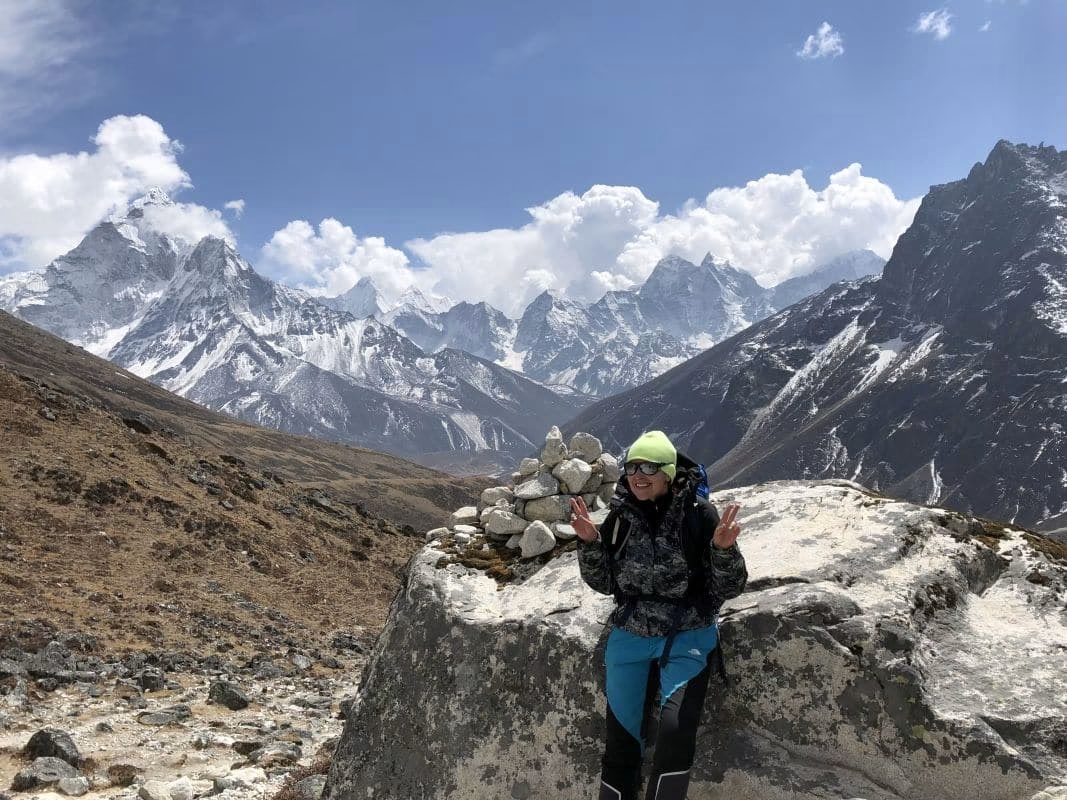
Day 14: Morning flight from Lukla to Kathmandu
Nepali food is delicious!! I like it much more than Indian food, although I’m a fan of both cuisines. Nutrition is key on any trek and you have to maintain it properly at high altitudes. If you are led by a guide he will make sure you eat enough, especially when you lose your apetite at higher levels. If you don’t eat properly that’s game over, your body will quickly loose energy and you’ll become too weak for high altitude activity. There is plenty of dishes to choose from in every restaurant/lodge on the way to Mount Everest Base Camp. My favourite would be:
1. Nepali Dal Bhat – definitely my favourite one!
2. Tibetan Bread
3. Spaghetti with Yak Cheese and Napolitana sause – I swear it was more tasty than Italian one !! ;)))
4. Noodle vegetarian soup
5. Garlic soup – you will need this one, as it helps your body to acclimatize. You may be even fed up with it at the end of the trail! I was! Haa!
6. Hot tea with ginger, lemon and mountain honey. Great for high mountains and your throat. I was on it almost all trek until my stomach collapsed from high vitamin C intake! hahha!
